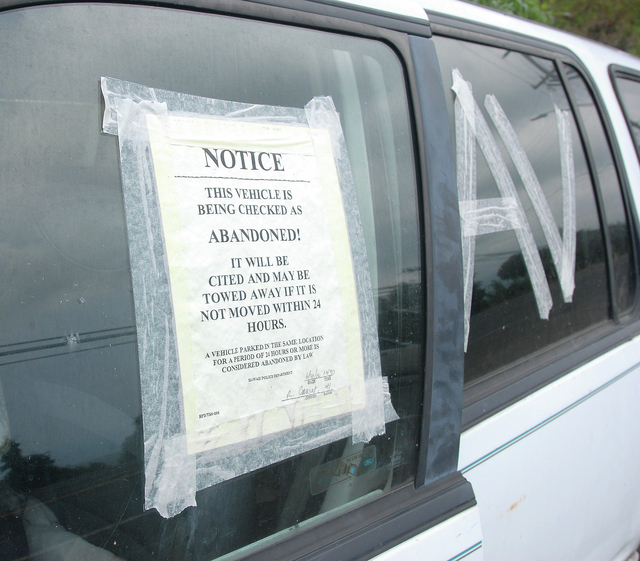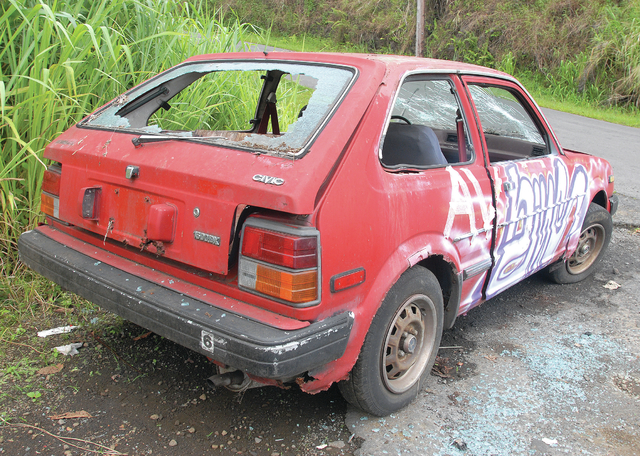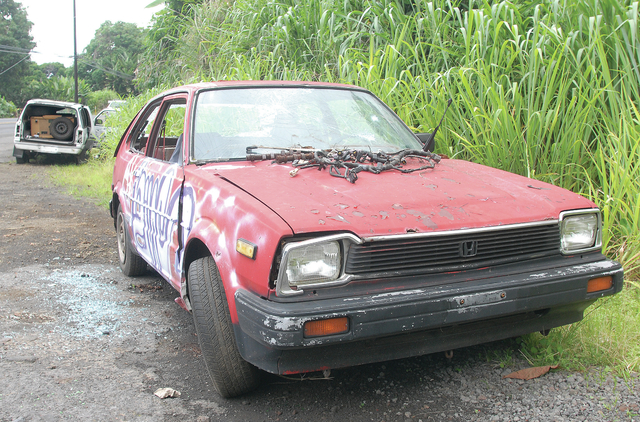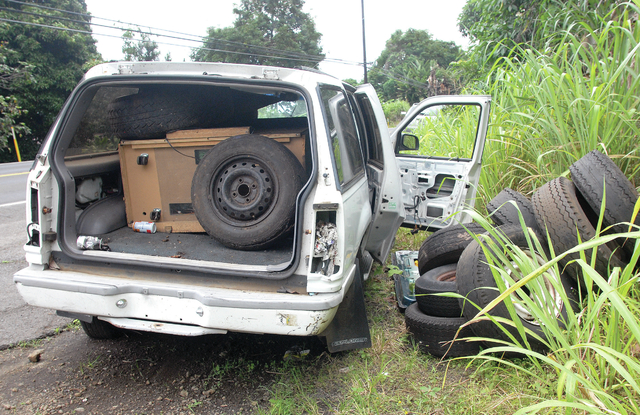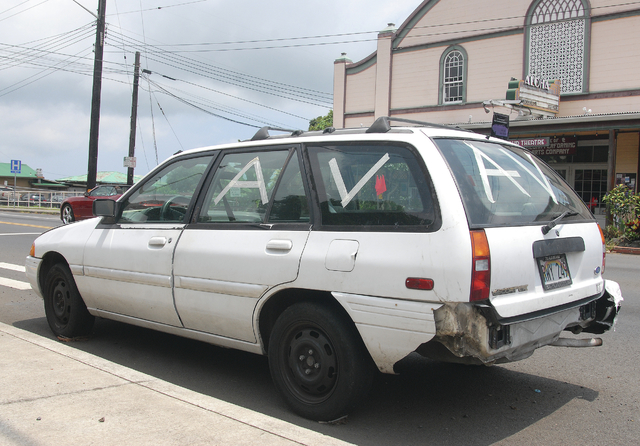KAILUA-KONA — Abandoned vehicles are piling up on roadsides in West Hawaii, and police are struggling with what Hawaii Police Department Sgt. Roylen Valera termed a massive littering problem. ADVERTISING KAILUA-KONA — Abandoned vehicles are piling up on roadsides in
KAILUA-KONA — Abandoned vehicles are piling up on roadsides in West Hawaii, and police are struggling with what Hawaii Police Department Sgt. Roylen Valera termed a massive littering problem.
Between Jan. 1 and June 22 more than 280 abandoned and derelict vehicles were reported in the Kona District, police said. That’s compared to the 106 over the same period last year. The district encompasses the physical North Kona and South Kona districts.
That’s more than double the number at this time last year.
So what’s going on? Well, there are a lot of theories out there, but officers are left scratching their heads.
“Because of the scale, you’re wondering what’s the deal? Why’s everyone dumping their cars?” Valera said.
Dumping a vehicle is a criminal offense punishable by up to a $1,000 fine, according to Hawaii Revised Statutes. Additionally, offenders could face a criminal littering charge, which is a petty misdemeanor and carries a fine of up to $1,000 and community service.
“It makes us look like a Third World country or a war zone,” Valera said.
That’s precisely what Christie Martin Edward is dealing with on her section of Mamalahoa Highway. She wrote a letter to the editor at West Hawaii Today recently describing vehicles that were abandoned, parts stripped and how it was all left with other garbage in what she termed the “Mamalahoa Pick and Pull.”
Although it carries stiffer penalties, Valera said “basically this is littering.” And it’s consuming police time that could be used for patrols, proactive actions and other duties.
It appears that some of the vehicles are abandoned when they break down, he said, and the drivers may intend to return. Others are stripped down to the frame before they are abandoned, and that leads Valera to believe a chop shop or backyard operation may be involved.
Police need the public’s help tracking down the offenders.
“We’re not everywhere 24/7. There’s always people walking, jogging or driving by,” he added.
Most reports come from officers on patrol, although some are called into dispatch. The vehicle is then tagged with a notice and police attempt to determine the owner. If it’s not moved within 24 hours, police may mark it as an abandoned vehicle with an “AV” and alert the Department of Environmental Management, whose Solid Waste Division manages the abandoned vehicle program.
After receiving notice, the division contacts a contracted tow company for the region, which usually remove the vehicle within a day, said Greg Dale, Solid Waste Division chief.
That is not what Edwards sees, as vehicles seem to stay on Mamalahoa Highway for six to eight weeks. That is despite her efforts to identify the people dumping the materials, she told West Hawaii Today, including photographs and other materials provided to police.
So why not just charge the owners?
It’s not as easy done as said. Here’s how it goes: Many of the abandoned cars are towed to impound lots, where county workers then work to contact registered owners. If a vehicle remains long enough, it is considered property of the county. Vehicles deemed valuable enough to matter are then disposed of by auction, while the rest are sent to scrap companies, which generally crush the vehicle and send it off island.
Although registered owners can be cited for the offense, the department has no way to recover the cost of the tow or scrapping.
Currently, the program’s budget is running in the red, officials said, because low scrap metal prices have resulted in less money being recovered. Also, it’s not always that easy locating the owner, Valera said. Some of the vehicles are being dumped with their license plates removed and the VIN removed.
When officers contact some registered owners, it turns out they had sold it and not informed the state of the sale. This leaves them liable for the removal of the vehicle.
Dale said one of the major reasons for the increase in vehicles on Kona roadways has been the drop in cost of scrap metal. That means that companies that used to pay for old vehicles are now charging.
Most of the metal in a car can only be sold for scrap, said Cody Henriques, company manager for Big Island Scrap Metal, which takes vehicles, but charges 5 cents per pound for it.
Without charging they’d lose money, said Henriques.
Valera asked that people who see a car being dumped or abandoned call the department’s nonemergency line at 935-3311.
“You gotta call us so we can get there from the other side of the district,” Valera said.
If residents spot a vehicle that is already abandoned, they should make a report to dispatch as well, he said, so that calls can be prioritized.
“We just want it to stop,” Valera said.


